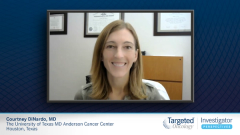
Safety Outcomes from the VIALE-A Trial
A review of the safety outcome data of venetoclax plus azacitidine from the VIALE-A trial.
Courtney DiNardo, MD: There are 3 main toxicities to think about when you’re using azacytidine and venetoclax. The first is tumor lysis syndrome, which is rare in patients with AML [acute myeloid leukemia]. You very rarely see tumor lysis. In the Viale-a study, there were 3 patients out of hundreds. If you’re going to see tumor lysis, it’s going to happen at the beginning, during the first 2 or 3 days of dosing. That’s why it’s important to do those labs during those first 3 days, to make sure your patient doesn’t have electrolyte derangements or isn’t developing renal insufficiency. That way, you can hold therapy and manage it. Tumor lysis is very manageable if you catch it before it becomes an issue.
The 2 main concerns in terms of safety are cytopenias and cytopenia-related infections. We talked a little about cytopenia management. For the inpatients who are in a remission with or without count recovery, you’ve cleared their leukemia. Oftentimes, with subsequent cycles, you’ve shortened the venetoclax duration. I frequently have patients on 21 days of venetoclax, and one-third or so end up needing 14 days of venetoclax for them not to become profoundly neutropenic and transfusion dependent, with subsequent ongoing cycles of patients in remission. Oftentimes, instead of 4-week cycles, I’m doing 5-week cycles to allow that full-count recovery to happen before I start the next cycle. That’s important, the somewhat-nuanced management guidelines, because each patient is a little different. I have a couple of patients on continuous venetoclax. They’re doing great. Their counts never budge in a remission. But that’s not [the case for] many patients. Most patients end up needing 14 or 21 days of venetoclax for 4-, 5-, or 6-week cycles. You end up getting a rhythm, but it can take a month or 2 to figure out exactly how much venetoclax your patient [needs]—what their happy place is in terms of maintaining that remission but keeping counts recovering without needing transfusions in cycles where they’re in a remission.
Then there are neutropenic-related infections. In patients who are on therapies that cause mild suppression and neutropenia—and leukemia itself causes immunosuppression—you can see neutropenic-related infections that are life-threatening. When individuals have fevers, when their ANC [absolute neutrophil count] is below 1000 per mm3, you need to have them on broad-spectrum antibiotics and make sure there’s no life-threatening infection. We typically give patients prophylaxis with fluoroquinolone if they don’t have an allergy. So they’re on levofloxacin and prophylaxis throughout the periods of neutropenia. It’s very institution and investigator dependent in terms of whether they’re also getting antifungal prophylaxis. During the first month or so when my patients have active leukemia and are immunosuppressed, I’ll have them on an antifungal and an antiviral for prevention as well.
Transcript edited for clarity.









































